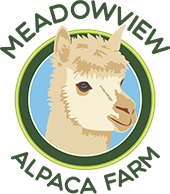Not all alpaca yarn and products are created equal.
Yes that’s right. Some products will be identified as pure alpaca but you will find it scratchy and rough. Why is that, you say? Well it all has to do with the preparation and batching of the fibre. Let me explain…
Preparing alpaca is an art and a science. Having a good quality end product is the result of much learning and years of practice… like anything else that is worth mastering. All producers need a basic knowledge of good fibre preparation, but then can access the skills of a qualified grader/sorter to help in final preparations for the mill.
At Meadowview Alpaca Farm we use The Harvest Code of Practice in order to prepare alpaca fibre for processing to ensure the best possible results in the development of finished products. The Code was designed to ensure the success of the alpaca industry across Canada and is one Meadowview Alpaca Farm happily contributed to.
Proper fibre preparation is esssential to produce a high quality product
Alpacas generally have a very good coverage of natural fibre on their whole body, however the fineness of the fibre is not equal on all parts of the body. The finest organic fibre is on the blanket—back and sides of the alpaca. Think of a saddle blanket extended. The upper legs become coarser and, over time, begin to show more guard hair. The chest area, called the apron, generally has quite a bit of guard hair, which again, increases and becomes coarser as the animal ages. The neck fibre is usually about the same fineness as the blanket, but much shorter and so cannot be processed with the blanket. The result is, that at shearing time, these areas must be separated immediately in order to avoid contamination of the best quality fibre...that is the blanket. For each animal, we separate the fleece into four bags: the blanket, the neck, the legs or seconds and the apron. Each are combined into one bag and labeled with the animal’s name.
The other issue important to deal with on shearing day is cleanliness. It is very important to send a “clean” fleece to the mill. One filled with vegetation will still have vegetation when the yarn comes back. Too much vegetation will cause problems with the carding machines in processing and will likely be refused by the mill. We make every effort to clean the fleeces even before they are removed from the animals by blowing dust and dirt from their coats and removing the vegetation.
This is what we do to ensure the delivery of a high-quality product to the consumer with the best fibre possible.
Fibre classing helps produce luxurous alpaca products
After shearing day, the bags of fibre that have been collected are put into batches for processing. The word of the day is “Uniformity,” as each batch must be similar in three essential characteristics: fineness, fibre length, and colour. During this process, we ensure that guard hair and vegetation are also removed.
The fibre is classed into six different grades. Grade One is considered to be the finest fibre, while Grade Six is the coarsest. A classer is responsible for making suggestions regarding the appropriate end product the fibre is suitable for. The quality of the fibre determines whether or not it is suitable for the production of a pair of socks, a scarf, a hat or any other. The classer places instructions into each bag for the next stage of processing. All this information is also stored electronically for future reference.
What factors are important to quality alpaca products?
From the alpaca farmer’s perspective, good fibre preparation means;
· Separating the natural fibre according to fineness, length and colour (although colours can be combined);
· Making sure that organic fibre sent for processing is clean and consistent; the key word is uniformity;
· Selecting the best end product for the wool—i.e. the finer grades are great for fine yarns being used close to sensitive skin areas but not great for alpaca wool socks which need to resist much wear and tear;
· Also selecting blends that combine the best characteristics of alpaca fibre with complementary traits of other fibres such as fine merino, silk, bamboo and others. These selections are also made keeping in mind the end product.
